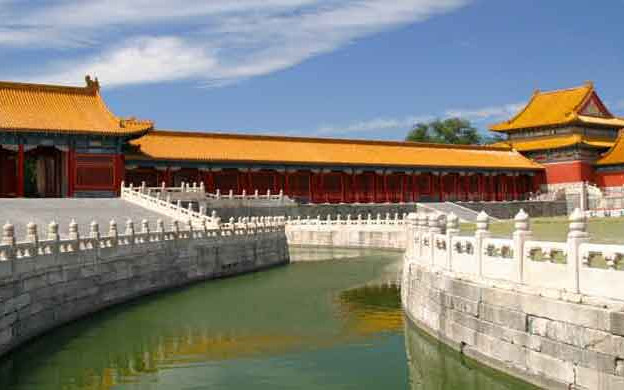Explorez la Chine, terre de mystères et d'histoire
Découvrez les merveilles de la Chine millénaire.
Un voyage en Chine est une aventure culturelle unique.
La Chine, un monde de découvertes et d'émerveillement
Mais l’Empire du Milieu, c’est aussi un pays qui a préservé ses traditions et sa culture, comme l’attestent ses nombreux trésors historiques à l’image de la Grande Muraille ou de la Cité Interdite.
Entre vieilles villes et modernité, la Chine offre également des paysages magnifiques comme les déserts infinis du Xinjiang, les campagnes reculées du Guizhou ou les sommets de l’Himalaya. C’est aussi une population très diversifiée puisque la Chine compte 55 minorités avec leurs propres coutumes, des Ouïghours de l’Ouest aux Tibétains, en passant par les Mongols ou les Mandchous. Un dépaysement qui sera aussi gustatif avec une cuisine chinoise plus qu’authentique avec le fameux canard laqué ou les différents raviolis à déguster sans modération !
Alors, pour découvrir au mieux toutes les facettes du pays, rien de tel qu’un voyage sur mesure en Chine organisé par une agence locale ! Grâce à des professionnels locaux, vous ferez un voyage authentique au cœur de la réalité chinoise.
Voyage sur mesure au cœur de l'Asie
Partir en voyage sur mesure en Chine vous permettra d'apprécier ce pays à sa juste valeur. Loin des a priori des voyageurs qui la réduisent trop souvent à ses grandes villes aux nombreux gratte-ciel, comme Pékin, Shanghai ou Canton, représentant une Chine moderne, vous découvrirez une richesse culturelle et historique inégalée. La barrière de la langue ne devrait pas vous empêcher de vous immerger dans ses traditions millénaires et ses paysages époustouflants. Chaque région offre des expériences uniques, des paysages naturels à couper le souffle aux monuments historiques fascinants. Le voyage sur mesure vous permet d'adapter votre séjour à vos envies, que ce soit pour explorer les merveilles naturelles, découvrir des traditions ancestrales ou s'immerger dans la vie locale.

Les étapes incontournables d'un voyage
La première image qui vient à l'esprit quand on évoque un séjour en Chine, c'est sa grande et majestueuse muraille crénelée qui ondule sur 6700 km. C'est un symbole fort de la civilisation chinoise et un incontournable pour tout voyage en Chine. Située à proximité de la Place Tian'anmen à Pékin, la Cité interdite est un autre site emblématique de la culture chinoise, concentrant de nombreux trésors impériaux de cette civilisation mythique. Lors de la visite, il est impressionnant de constater que tout semble préservé dans le même état qu'autrefois, gardant une trace d’une Chine traditionnelle. Protégée par des douves, la Cité interdite est aujourd'hui un véritable musée, le Musée du Palais. À Leshan, dans la province du Sichuan, se trouve un immense Bouddha inscrit au Patrimoine mondial de l'UNESCO. Avec ses 71 mètres de haut et ses 28 mètres de large, cette représentation est l'une des plus grandes du monde, très prisée dans le bouddhisme. Dans le Shaanxi, près de Xi'an, se trouve le tombeau de l'empereur Qin (IIIème siècle avant J.C.), considéré comme le fondateur de l’Empire du Milieu. Non loin de là, les vestiges ensevelis de milliers de soldats en terre cuite protègent son tombeau. L'ensemble du site s'étend sur près de 60 km².

Découvrir la Chine autrement
Les rizières en terrasses du Dos du Dragon sont souvent considérées comme les plus belles de Chine. Situées entre les villages de Pingan et Jinkeng, dans la province du Guangxi, elles ont été créées au 13ème siècle, à l'époque de la dynastie Yuan, et la tradition s'est poursuivie jusqu'au 17ème siècle, au début de la dynastie Qing. Il est possible d'y faire une randonnée au cœur des rizières, entre les étages et même au milieu des cultures.
À Chengdu, dans le Sichuan, le centre de recherche et de reproduction des pandas géants permet d'observer ces mammifères en voie de disparition. Le parc national de Jiuzhaigou, classé biosphère par l'UNESCO, abrite divers écosystèmes avec plus de 140 espèces d'oiseaux et de nombreuses espèces végétales et animales comme le panda géant. Très visité l'été, il est réputé pour ses lacs aux couleurs émeraude et turquoise ainsi que ses magnifiques chutes d'eau.
Pour les amateurs de sensations fortes, le pont de verre de Zhangjiajie, inauguré en 2016, est le plus haut et le plus long du monde. Il peut accueillir jusqu'à 800 visiteurs à la fois. Situé au cœur des montagnes de Zhangjiajie, ce pont suspendu à 180 mètres de haut relie deux sommets du parc naturel du Hunan. Les plus téméraires peuvent y sauter à l'élastique ou emprunter une tyrolienne.
Pékin : ville de tous les possibles
Pékin concentre en son sein des dizaines de possibilités pour les voyageurs, fortunés ou non. Si vous aimez les voitures de luxe, une soirée devant le Village de Sanlitun vous permettra de voir un incessant ballet de grosses cylindrées, certaines tunées de manière assez intrigante. Pour les amoureux de la culture chinoise traditionnelle, un passage dans les hutongs du centre-ville vous permettra de toucher du doigt l'âme de la capitale et de ses habitants.
Pour les contemplateurs de prouesses architecturales, ne manquez pas un passage, même rapide, au centre des affaires de Chaoyang, entre la tour CCTV et le mall The Place. Les passionnés d'histoire se réjouiront lors d'un voyage dans le temps entre la Cité interdite, Tian'anmen ou l'ancien quartier des légations. Oui, un voyage à Pékin regroupe tout ceci et bien plus encore.
Shanghai : ville marquée par l'histoire et la politique
Grâce à un héritage architectural relativement bien préservé jusqu'à ce jour, l'histoire de Shanghai se lit sur les murs des vieilles demeures, dans les couloirs d'un hôtel Art Déco des années 1930, au cœur d'un parc. La ville, dans son architecture, a été très marquée par la présence étrangère des Occidentaux et des Japonais. Les quartiers des anciennes concessions sont encore aujourd'hui clairement définis.
La ville de Shanghai a été et reste un véritable "laboratoire du changement". Le Parti communiste chinois y fit ses premiers pas au début des années 1920. Les premières révoltes ouvrières organisées par les communistes se déroulèrent dans la ville des années 1930. Shanghai devint le théâtre des premiers affrontements entre nationalistes et communistes quelques années plus tard. L'instabilité en Chine laissa le champ libre aux Japonais, qui attaquèrent la ville sans sommation au mois d'août 1937. Toutes ces péripéties historiques ont bien évidemment laissé leur marque à Shanghai. On peut y visiter les maisons de nombreux personnages politiques, comme Sun Yat-sen, Zhou Enlai ou Song Qingling ; découvrir le site où s'est déroulé le premier congrès du Parti communiste ; explorer les musées retraçant l'histoire des concessions, avec photos et même films d'époque à l'appui.
A website by
Customize your trips with Quotatrip and receive tailor-made offers directly in your inbox.
Discover a country
Copyright 2025 © Quotatrip.